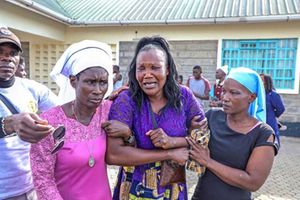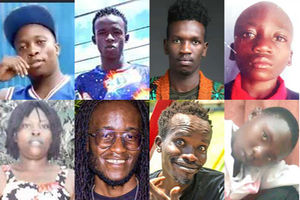
Kenyatta Avenue and Kaunda Street with the sign of Rex Masai, the first fatality in the Anti-government protests.
How did a five-year-old boy from Githurai end up in hospital with a bullet in his chest on the night many gunshots were heard in the area?
That is one of the questions the Independent Policing Oversight Authority (Ipoa) is asking as it seeks to bring to book the officers who used excessive force during anti-Finance Bill, 2024 protests.
Pressure is also mounting on President William Ruto to account for the many instances of security agents killing, maiming, abducting and teargassing protesters and government critics.
From his engagement on X Spaces on Friday, Dr Ruto has a dual response to the police actions.
On one hand, he promised investigations and disciplinary action while on the other, he maintained that the National Police Service is are independent.
When informed about a trigger-happy policeman, President Ruto asked for the video of the officer.
“Please forward the picture and photos to me, to (Mohamed) Hussein, my spokesman here. I would also appreciate if you can send it to my inbox or Ipoa. We will deal with it,” the President said.
Financial autonomy
However, in what seemed like distancing himself from the police actions, he insisted that law enforcers act independently.
Citing the Executive order he signed immediately took office, which gave police financial autonomy, Dr Ruto said his administration has a different approach to policing.
“I did not want my office to decide for the police on who to arrest, who to charge or how to pursue corruption. I provide policy. The police run independently. If you read the Constitution of Kenya, the police is an independent institution. It doesn’t take instructions from me, the Chief Justice, Speaker or from the Legislature,” he said.
“They act independently. I agree, good people, that innocent lives were lost, and one life lost is one too many.”
He added that 25 Kenyans died in the demonstrations that rocked most parts of the country in the last two weeks.
Over the last week, burials of those killed in the protests have been taking place across Kenya.
The latest was at Lang’ata Cemetery in Nairobi on Saturday, July 6, while Rex Masai who was shot dead on June 20 was buried in Machakos County on Friday.
At Rex’s burial, Wiper party leader and former Vice-President Kalonzo Musyoka said the young man’s death would not be in vain.
“He has contributed to changing the way this country is governed forever,” Mr Musyoka told the mourners.
Amid sobs, activist Boniface Mwangi told the crowd: “Rex died a hero, and we demand justice for Rex.”
From the Ipoa website, the Sunday Nation tabulated the deaths and injuries being investigated.
Rex is among them. Ipoa says he was killed by an officer in civilian clothing on June 20 around 7.15pm.
The authority attended the post-mortem of his body on June the following day.
Recorded witness statements
Ipoa says it has recorded witness statements, obtained police documents and analysed CCTV plus other video footage.
The other is Evans Kiratu. He was shot in Nairobi on the same day Rex was killed and died the following day at Kenyatta National Hospital (KNH).
Ipoa officials also attended the post-mortem on the body on June 25. It has also visited the scene Kiratu was injured and collected evidence.
The authority says it has summoned police officers to record statements.
Eight bullets, one bullet
Then there is Andrew Mwawasi. He was killed at the Kenya Mpya stage in Githurai on June 25 and the body taken to the City Mortuary. Ipoa attended the post-mortem of his remains and recorded witness statements. Mwawasi was buried at Lang’ata Cemetery yesterday. The burial was attended by Mr Mwangi, Mr Hussein Khalid, Ms Hanifa Adan and several other activists.
Still in Githurai, there is the puzzling case of Gianna Merkel Obonyo, a five-year-old.
“(He had) a bullet in his chest. He was taken to KNH and has since been treated and discharged,” says Ipoa, adding that it has requested the boy’s medical documents.
Kennedy Onyango was another boy who was hit by bullets in Rongai on June 27. Unlike Gianna, he did not survive.
The 12-year-old has been a subject of controversy – first on the number of bullets that hit him and who caused his death.
Denying reports of eight bullets pumped into the boy, Dr Ruto insisted that Onyango was felled by one bullet fired by a “criminal” who had snatched a gun from a police officer.
“That criminal was, however, shot by police,” said Dr Ruto at the X Spaces forum on Friday.
“If police did not shoot him, he would have caused more deaths.”
On the number of bullets, the President said: “The one that was being said of eight bullets did not exist. In fact, we have now found out that the one of eight bullets happened several years ago somewhere in Buruburu, and it was a completely different scenario.”
Ipoa says it attended the Onyango’s post-mortem.
Other deaths on the Ipoa investigations diary arise from June 25 when protesters stormed Parliament.
The authority says it knows of 11 deaths in Nairobi that Tuesday. The ones being investigated are those of Ibrahim Kamau Wanjiku, Erickson Kyalo, David Chege, Wilson Sitati, Kelvin Odhiambo Maina and Kenneth Njeru Mwangi, whose post-mortems it attended.
Rights defenders are piling pressure on Dr Ruto’s administration to take responsibility for the death.
Among them is the Kenya National Commission on Human Rights (KNCHR), a constitutional agency, which has recorded 39 deaths across the country.
“The dead are from Nairobi (17), Nakuru (three), Laikipia (one), Narok (one), Kajiado (three), Uasin Gishu (four), Kakamega (one), Kisumu (two), Kisii (one), Mombasa (three), Siaya (one), Kiambu (one) and Nandi (one),” the commission said on Monday.
“KNCHR reiterates that the government has an obligation to facilitate the rights of protesters through providing security to ensure law and order,” commission chairperson Roseline Odede said.
The Law Society of Kenya has also condemned the killings.
“In a bid to raise an extra Sh346 billion via the Finance Bill, 2024, blood must be shed. Every Kenyan who has lost his or her life in the struggle to stamp out corruption and seek economic liberation lies in the hands of a rogue and inconsiderate President. I congratulate you because history will remember you as the President that had to kill his people to raise more money,” LSK President Faith Odhiambo said in a hard-hitting press release on the day Parliament was invaded.
Mr Mwangi tweeted on Saturday: “No one had to die for the government to listen.”
Did you record a video that captured a police officer using excessive force during the recent anti-government protests?
Ipoa has created a platform through which you can drop such a video. It is on https://forms.gle/atyrL593UmyVx1WFA.
“Members of the public are also urged to visit Ipoa offices and provide witness accounts,” the authority said in a post on its website on Friday.










